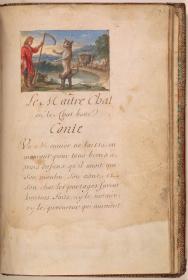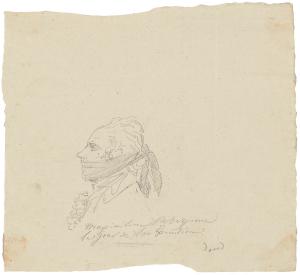Collecting History. The collection of the Department of Literary and Historical Manuscripts is among the most intensively consulted at the Morgan and serves the research needs of a broad and diverse scholarly and non-scholarly community. It includes complete manuscripts and working drafts of prose, poetry, and drama. The collection also includes correspondence, journals, diaries, interviews, and other documents of important American and European authors, artists, scientists, explorers, and historical and religious figures from the thirteenth to the twenty-first century. The variety of material forms that the collection encompasses—manuscripts, letters, charters, contracts, deeds, indentures, gift rolls—illustrates a wide-ranging and comprehensive history of nine centuries of written human communication in the West. The handwritten documents in the collection preserve the process of human thought and creativity—from mind to pen to paper—with an immediacy and power lacking in texts produced electronically.
In collecting autograph manuscripts, Pierpont Morgan did not seek to achieve comprehensiveness in any particular field but rather to assemble important documents related to events of major historical significance, manuscripts that document the lives of notable individuals, and manuscripts that represent the genesis of great literary works. Morgan acquired thousands of letters and documents of the royal houses and nobility of England and Europe, presidents of the United States, popes and other clergy (especially of the Protestant Episcopal Church), as well as writers and artists. The collection is rich in authors’ drafts that allow scholars to trace the evolution of a work, in some cases from original inspiration to final product, and in authors’ correspondence with contemporaries, collaborators, publishers, family, and friends.
Since Morgan’s death in 1913, the development of the collection has traditionally been guided by the following principles: to acquire manuscripts of American and English literature, and writers’ and artists’ letters and papers, that are similar in character to those already in the collection in order to build on existing strengths; to acquire material that complements the Morgan’s holdings in printed books and drawings and prints; to collect in areas where American libraries have tended to lag behind their European counterparts, such as Continental literature and autograph letters and documents of the Italian Renaissance; and to establish new collections in areas where the Morgan is under-represented, such as the twentieth century.
 Jane Austen (1775–1817), Autograph letter to Cassandra Austen, signed and dated Godmersham, June 20 and 22, 1808. Purchased by J.P. Morgan, Jr., 1920. MA 977.16.
Jane Austen (1775–1817), Autograph letter to Cassandra Austen, signed and dated Godmersham, June 20 and 22, 1808. Purchased by J.P. Morgan, Jr., 1920. MA 977.16.Jane Austen (1775–1817), Autograph letter to Cassandra Austen, signed and dated Godmersham, June 20 and 22, 1808. Purchased by J.P. Morgan, Jr., 1920. MA 977.16.
British Literary Manuscripts. Literary manuscripts and correspondence by British authors represent one of the strongest areas in the collection and include manuscripts by John Milton, Alexander Pope, Samuel Johnson, Jonathan Swift, Samuel Richardson, Robert Burns, William Blake, Lord Byron, John Keats, Percy Bysshe Shelley, William Wordsworth, Fanny Burney, Walter Scott, the Brontës, Charles Dickens, Elizabeth Barrett Browning, William Thackeray, Anthony Trollope, Wilkie Collins, George Eliot, Lewis Carroll, John Ruskin, Oscar Wilde, and J. M. Barrie.
The Morgan holds fifty-one letters written by Jane Austen, which represent a third of all surviving letters and is by far the largest number in any public or private collection, as well as the only surviving complete manuscript of any of her novels. The Morgan holds the complete manuscript of A Christmas Carol, as well as two more of Dickens’s Christmas stories, the manuscript of his last published novel, and more than 1,400 letters, of which some 600 are to the philanthropist Angela Burdett-Coutts. The Morgan also owns the largest single collection of letters by the Romantic poet Samuel Taylor Coleridge, and nearly 600 letters from John Ruskin to the illustrator Kate Greenaway. Notable items of correspondence include love letters by Oscar Wilde to his wife Constance and to Lord Alfred Douglas.
The Kenneth A. Lohf collection of British poetry is comprehensive in holdings related to poets of the First and Second World Wars, and includes roughly 400 manuscripts and letters by authors such as W. H. Auden, Rupert Brooke, Siegfried Sassoon, and Edith Sitwell. The Man Booker Prize collection, which includes manuscripts, correspondence, ephemera, and photographs, documents the submissions and judging process of that literary prize since 1969.
American Literary Manuscripts. Pierpont Morgan began to acquire the manuscripts of notable American authors in 1895 with Fenimore Cooper’s The Deerslayer. He augmented this collection by acquiring, en bloc in 1909, the Stephen H. Wakeman Collection and added two important manuscripts by Mark Twain in the same year. Other important American manuscripts include those of Henry David Thoreau, Ralph Waldo Emerson, Edgar Allen Poe, and Nathaniel Hawthorne. Walt Whitman and Emily Dickinson are represented by poetry drafts and correspondence.
In the 1950s John Steinbeck donated several important manuscripts, journals, and speeches, and the Morgan has acquired significant correspondence by Steinbeck in recent years. The Carter Burden Collection of American Literature and The Paris Review Archive added important manuscripts and correspondence by James Baldwin, John Cheever, J. D. Salinger, Tennessee Williams, John Ashbery, Sylvia Plath, Anne Sexton, William S. Burroughs, Jack Kerouac, and Allen Ginsberg. Access to the George and Marie Hecksher Collection of Bob Dylan manuscripts is currently restricted.
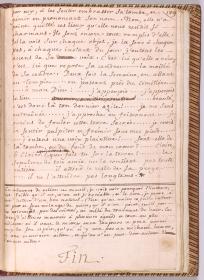 Jean Jacques Rousseau (1712–1778). Nouvelle Héloïse. Autograph manuscript, ca. 1759. The Dannie and Hettie Heineman Collection. Gift of the Heineman Foundation, 1977. MA 6711.
Jean Jacques Rousseau (1712–1778). Nouvelle Héloïse. Autograph manuscript, ca. 1759. The Dannie and Hettie Heineman Collection. Gift of the Heineman Foundation, 1977. MA 6711.Jean Jacques Rousseau (1712–1778). Nouvelle Héloïse. Autograph manuscript, ca. 1759. The Dannie and Hettie Heineman Collection. Gift of the Heineman Foundation, 1977. MA 6711.
Continental Manuscripts. The Morgan holds the largest collection of Voltaire manuscripts and letters in the United States, as well as significant manuscripts by Jean-Jacques Rousseau, Émilie du Châtelet, Madame Roland, Paul Verlaine, Honoré de Balzac, Madame du Barry, Anatole France, Victor Hugo, George Sand, Guy de Maupassant, Émile Zola, Alphonse de Lamartine, and Jean Cocteau. German manuscripts include works by Goethe and his circle, including some seventy-five letters between Goethe and Bettina von Arnim, as well as manuscripts and correspondence of Heine, Schiller, and Einstein. A significant portion of the French and German manuscript material was donated in 1977 by Dannie and Hettie Heineman and has been augmented through occasional, continuing acquisitions on the Heineman Fund.
Children’s Literature. The collection includes important holdings in children’s literature, dating from the late seventeenth century illustrated manuscript of Charles Perrault’s Contes de ma mère l’Oye to Marianne Moore’s twentieth century typescript translations of “Puss in Boots” and other Perrault tales. The collection also includes Antoine de Saint-Exupéry’s working draft of Le Petit Prince together with his thirty-eight full page watercolor drawings for the book and E. B. White’s complete file, including notes, drafts, and sketches, for The Trumpet of the Swan. The Arthur A. Houghton Collection of Lewis Carroll, which was donated to the Morgan in 1987, is one of the most important Lewis Carroll collections in the United States. It includes first editions, photographs, and original artwork, as well as extensive correspondence, notes, poems, games, and other material related to Lewis Carroll and Alice’s Adventures in Wonderland.
 Giovanni Battista Piranesi (1720–1778), Autograph letter to Charles Townley illustrated with a drawing of the Warwick Vase, signed and dated Rome, 3 August 1772. Purchased as the gift of Mr. John P. Morgan II, Miss Julia P. Wightman, and Mrs. Charles Wrightsman in memory of Mrs. J.P. Morgan in 1985. MA 4220.
Giovanni Battista Piranesi (1720–1778), Autograph letter to Charles Townley illustrated with a drawing of the Warwick Vase, signed and dated Rome, 3 August 1772. Purchased as the gift of Mr. John P. Morgan II, Miss Julia P. Wightman, and Mrs. Charles Wrightsman in memory of Mrs. J.P. Morgan in 1985. MA 4220.Giovanni Battista Piranesi (1720–1778), Autograph letter to Charles Townley illustrated with a drawing of the Warwick Vase, signed and dated Rome, 3 August 1772. Purchased as the gift of Mr. John P. Morgan II, Miss Julia P. Wightman, and Mrs. Charles Wrightsman in memory of Mrs. J.P. Morgan in 1985. MA 4220.
Artists’ Letters and Original Artwork. The collection is particularly strong in artists’ letters from the Renaissance to the twentieth century, including the journals of Stuart Davis and Charles Seliger. Papers related to Sir John Everett Millais include over 800 letters written to Millais and his family. William Morris and the Rossettis are well-represented by correspondence and manuscripts. The Tabarant collection includes hundreds of letters and photographs related to Édouard Manet and his works. There are nineteen letters from Van Gogh to Emile Bernard, many of which are illustrated. The collection also includes illustrated letters by artists such as Piranesi, Edward Lear, Beatrix Potter and Philip Guston.
During the past twenty-five years, important acquisitions have included the art historian John Rewald’s letters of Impressionist and Postimpressionist artists, including Chagall, Dali, Matisse, and Giacometti, and the art dealer Paul Rosenberg’s collection of letters and documents by twentieth-century artists. The Pierre Matisse Gallery Archive added enormous strength to the collection of artists’ letters, and this archive is generally the most actively used part of the Morgan’s collection of literary and historical manuscripts. This collection, which was the gift of the Pierre Matisse Foundation in 1997, includes more than 1,500 letters and more than 200 original works of art as well as records of the gallery installations of Balthus, Chagall, Dubuffet, Giacometti, Miró, and other major twentieth-century artists. There are over 1,000 New Yorker cartoons in the Melvin R. Seiden Collection, including work by artists such as Saul Steinberg and Jules Feiffer. The collection also includes correspondence.
![Elizabeth I, Queen of England (1533–1603), Autograph letter to Thomas Seymour, Baron Seymour of Sudeley, Lord Admiral of England, signed and dated [Hatfield?], summer of 1548. From Paston & Thane Collections. MA Unassigned.](/sites/default/files/styles/mediumxextralarge__320_x_320_/public/images/research/elizabeth-i-126654_0001.jpg?itok=Jc0tAG5N) Elizabeth I, Queen of England (1533–1603), Autograph letter to Thomas Seymour, Baron Seymour of Sudeley, Lord Admiral of England, signed and dated [Hatfield?], summer of 1548. From Paston & Thane Collections. MA Unassigned.
Elizabeth I, Queen of England (1533–1603), Autograph letter to Thomas Seymour, Baron Seymour of Sudeley, Lord Admiral of England, signed and dated [Hatfield?], summer of 1548. From Paston & Thane Collections. MA Unassigned.Elizabeth I, Queen of England (1533–1603), Autograph letter to Thomas Seymour, Baron Seymour of Sudeley, Lord Admiral of England, signed and dated [Hatfield?], summer of 1548. From Paston & Thane Collections. MA Unassigned.
Historical Manuscripts. Historical collections include documents related to British and Continental monarchs, royal families, and courtiers. Elizabeth I is represented by numerous signed documents, as well as personal letters, such as one she wrote as a teenager to Thomas Seymour, and a 1596 New Year’s gift roll. The Mary Stuart collection includes forty volumes of manuscripts, mostly contemporary, relating to Mary Queen of Scots. The Murray-Pulteney correspondence includes more than 1,750 letters by or to Sir William or Sir James Murray-Pulteney spanning half a century of the reigns of George III and George IV. There are documents, letters, and caricatures relating to the trial of Warren Hastings as well as autographs of the English regicides.
Manuscripts covering the history of exploration in the New World include a portion of the original journal of the town of Cuzco, Peru, from 1433; a contemporary copy of Verrazzano’s 1524 letter to Francis I regarding his exploration of the east coast of America; and the 1586 manuscript Histoire naturelle des Indes, which may be a record of the early explorations of Sir Francis Drake and is illustrated with 199 separate images of West Indian plants, animals, and Indian life with accompanying captions written in late sixteenth-century French. The collection also includes a group of letters from Emmanuel Altham that document the settlement of Plymouth Plantation and describe the abundant landscape of the northeast.
American historical manuscripts include extensive collections of autographs of signers of the Declaration of Independence, correspondence by George Washington, 173 letters from Thomas Jefferson to his daughter spanning the years 1784–1819, and the Yorktown correspondence, which includes approximately 300 letters and documents, chiefly from the year 1781, relating to the Yorktown campaign.
The Leon Levy Foundation Archives and Catalogues Program
In 2007, the Leon Levy Foundation made an initial grant to the Morgan Library & Museum to launch a project to enhance online catalog descriptions for targeted areas of its collection of literary and historical manuscripts. Now approaching a decade of support, the Leon Levy Foundation has facilitated the most substantive study of aspects of the literary and historical manuscripts collection in the Morgan’s history.
Prior to the start of this project, many collections containing letters, manuscripts, historical documents, engravings, photographs and drawings, as well as some printed items and ephemera were described very briefly in a single record in CORSAIR, the Morgan’s online catalog. The Leon Levy Foundation has made the systematic physical examination of targeted portions of the collection possible, resulting in the creation of individual catalog records that now include contextual notes and summaries as well as indexed names and subjects. Many of the items previously uncataloged—such as a Robert Burns manuscript, a sketch by Jacques Louis David of Robespierre on the day of his execution, and self-portraits by American poet E. E. Cummings—were unstudied and even unknown to the scholarly community.
The work accomplished by a dedicated team of catalogers under the auspices of the Leon Levy Foundation has significantly increased the research value of the Morgan’s literary and historical manuscripts, laying the foundations for the important critical study of the collection by humanities scholars. For researchers throughout the world, for whom CORSAIR is the essential point of access to these extraordinary holdings, this work has been nothing short of transformative.
To learn more about the work of the Leon Levy Foundation Archives and Catalogues Program, visit the Leon Levy Foundation.
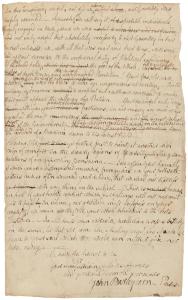 Robert Burns (1759–1796), Address of the Scots distillers. Manuscript, signed "John Barleycorn" and dated ca. February 1789. Purchased by Pierpont Morgan, 1910. MA 655.
Robert Burns (1759–1796), Address of the Scots distillers. Manuscript, signed "John Barleycorn" and dated ca. February 1789. Purchased by Pierpont Morgan, 1910. MA 655.Robert Burns (1759–1796), Address of the Scots distillers. Manuscript, signed "John Barleycorn" and dated ca. February 1789. Purchased by Pierpont Morgan, 1910. MA 655.
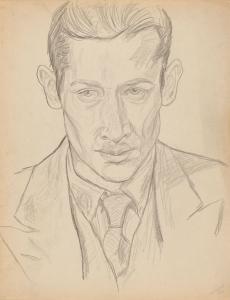 E. E. Cummings (1894–1962), Self portrait, 29 November 1926, Graphite on paper. Anonymous gift, 1971. MA 4291.51. © by the Trustees for the E.E. Cummings Trust
E. E. Cummings (1894–1962), Self portrait, 29 November 1926, Graphite on paper. Anonymous gift, 1971. MA 4291.51. © by the Trustees for the E.E. Cummings TrustE. E. Cummings (1894–1962), Self portrait, 29 November 1926, Graphite on paper. Anonymous gift, 1971. MA 4291.51. © by the Trustees for the E.E. Cummings Trust
Research and Access
The Morgan’s holdings of literary and historical manuscripts are described in the online collections catalog CORSAIR. Additional finding aids provide access to The Paris Review Archive and the Pierre Matisse Gallery Archive.
For more information about the Morgan’s institutional archives, which include the personal papers of Pierpont Morgan and his immediate family, early records of the Morgan financial firms, and the records of the institution, please see the Research Guide to that collection.
A portion of the collection has been digitized and researchers may request photography of manuscript materials for remote study. Scholars are also welcome to make an appointment in the Sherman Fairchild Reading Room to research the collection. For more information about reading room policies, and to complete an application, please see the Reading Room FAQs. Research questions and other inquiries about the collection may be directed to manuscripts@themorgan.org.



